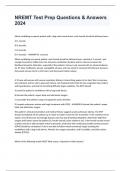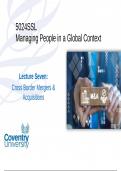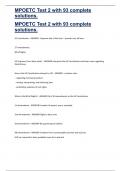Contents
1.0 Introduction to Accountability and Risk Management ..........................................................................2
Lecture 1 Recording - Part 1 .................................................................................................................2
Lecture 1 Recording - Part 2 .................................................................................................................2
Lecture 1 Recording - Part 3 .................................................................................................................6
Lecture 1 Recording - Part 4 – paper review - Flyvbjerg 2006 ...............................................................6
Seminar 1 - paper review - Spira and Page (2003) ...............................................................................6
2.0 Accountability, Internal Control and Fraud ........................................................................................10
Lecture 2 Recording - Part 1 ...............................................................................................................10
Lecture 2 Recording - Part 2 ...............................................................................................................13
Lecture 2 Recording - Part 3 – paper review - Gabbionetta et al. 2013 ...............................................13
Seminar 2 - paper review - Gendron and Spira 2009 ..........................................................................16
Seminar 2 - paper review - Neu et al. 2013 .........................................................................................19
3.0 Risk Management in Context ............................................................................................................23
Lecture 3 Recording - Part 1 ...............................................................................................................23
Lecture 3 Recording - Part 2 – paper review – Taleb et al. (2009) ......................................................27
Lecture 3 Recording - Part 3 – paper review – Kapla et al. (2020) ......................................................29
Lecture 3 Recording - Part 4 – paper review – Power (2009) ..............................................................31
Seminar 3 - paper review - Arena et al. (2010)....................................................................................33
Seminar 3 - paper review - Hayne and Free 2014 ...............................................................................36
4.0 Accountability for Sustainable Business 1: Expansions in risk management practice and disclosure41
Lecture 4 Recording - Part 1 ...............................................................................................................41
Lecture 4 Recording - Part 2 ...............................................................................................................47
Lecture 4 Recording - Part 3 - paper review - O'Dwyer and Unerman 2020 ........................................53
Seminar 4 - paper review - Caldarelli et al. 2016 .................................................................................61
Seminar 4 - paper review - Humphrey et al. 2017 ...............................................................................64
5.0 Accountability for Sustainable Business 2: The rise of responsible invest .........................................68
Lecture 5 Recording - Part 1 ...............................................................................................................68
Lecture 5 Recording - Part 2 – paper review - Clune and O'Dwyer 2020.............................................75
Seminar 4 - paper review - Diouf and Boiral 2017 ...............................................................................79
Seminar 4 - paper review - Kreander and McPhail 2019 .....................................................................82
6.0 Accountability of the Accounting Profession .....................................................................................88
Lecture 6 Recording - Part 1 ...............................................................................................................88
Lecture 6 Recording - Part 2 – paper review - Canning and O'Dwyer 2016.........................................93
,1.0 Introduction to Accountability and Risk Management
Lecture 1 Recording - Part 1
Lecture 1 Recording - Part 2
Lecture outline
1. Accountability and corporate governance
2. Risk management and corporate governance
3. The nature of accountability
4. The nature of risk management
5. The evolution of risk management
The boundaries of corporate governance (Cadbury, 1999)
Corporate governance is an umbrella term
• includes specific issues arising from interactions
o among senior management, shareholders, boards of directors, and other corporate
stakeholders
‘Concerned with holding the balance between economic and social goals and between individual and
communal goals
… the aim is to align as neatly as possible the interests of individuals, corporations and society.’
(Cadbury, 1999)
Principles underlying corporate governance in NL
• A company is:
o a long-term alliance between the various parties involved in the company
• … the stakeholders are the groups and individuals who, directly or indirectly, influence – or are
influenced by – the attainment of the company’s objectives
o employees, shareholders and other lenders, suppliers, customers, the public sector and civil
society
• the management board and the supervisory board have overall responsibility for weighing up these
interests
o with a view to ensuring the continuity of the enterprise, while the company endeavors to
create long-term shareholder value
Accountability and corporate governance
• Financial scandals have driven evolutions in corporate governance
• Codes and Principles abound
o key focus on improving transparency, internal control,
o accountability for stakeholder groups
• Corporate (organizational) governance is therefore partly aimed at improving corporate
(organizational) accountability
Risk management and corporate governance (1)
• Purpose of corporate governance:
o to facilitate effective, entrepreneurial, and prudent management that can deliver the long-term
success of the company
• The board of directors (management board) are, inter alia, responsible for:
o determining the nature and extent of the significant risks it is willing to take in achieving its
strategic objectives
o the maintenance of sound risk management and internal control systems
• In other words, risk management is a core component of corporate governance
,Risk management and corporate governance (2)
Responses to financial scandals continually emphasize the role of risk management in corporate
governance
Corporate governance failures partly blamed on:
• Failure in risk management systems
• Lack of information about risk exposures reaching boards
• Lack of board monitoring of risk management
• Lack of disclosure of risks and their management
• Lack of embedding of risk management strategic decision making
The nature of accountability- - - - - - - - - - - - - -
Accountability and corporate governance (1)
• Accountability: fluid concept at the heart of corporate (organizational) governance
• The giving and demanding of reasons for conduct
• Identifying what one is responsible for and then providing information about that responsibility to
those who have rights to that information
Accountability and corporate governance (2)
“[A]t the heart of accountability is a social acknowledgement and insistence that one’s actions make a
difference both to self and others” (Roberts 1991, p.365)
Two dimensions:
Accountability dimensions
• Why? > motivation/ drivers
• To whom? > forms of accountability
• For what/ how? > mechanisms/ initiatives
Hierarchical Accountability
• Short term functional orientation
• Resource use, immediate quantifiable impacts
• External factors – oversight and control
• Prioritizes upward, short-term accountability to powerful patrons like shareholders
Holistic Accountability
• Augments hierarchical accountability
• Accountability for broader, sustainable impacts
• Embraces accountability to broad sets of stakeholders
The nature of risk management - - - - - - - - - - - - - - - - - -
Risk management (1)
• Encompasses the identification of risk factors that form part of the life of a business
• The analysis of risk factors that form part of the life of a business, and
• The response to risk factors that form part of the life of a business
Effective risk management:
• Attempts to control, as much as possible, future outcomes by acting proactively rather than
reactively
• Offers the potential to reduce both the possibility of a risk accruing and its potential impact
, Risk management (2)
• A process that allows individual risk event and overall risk to be understood and managed
proactively
• Optimizes success by minimizing threats and maximizing opportunities and outcomes
This definition avoids a mitigation mindset by embracing opportunities
Risks to be managed?
• Preventable risks
• Strategy risks
• External risks
Preventable risks
• Internal risks
• Controllable and ought to be eliminated or avoided
Examples:
• The risks from breakdowns in routine operational processes
• The risks form employees and managers unauthorized, illegal, unethical, incorrect, or
inappropriate actions
Adopts a compliance, rules-based approach to risk management
Strategy risks
• Not inherently undesirable
• A company voluntarily accepts some risk in order to generate superior returns from its strategy
o Banks take a credit risk
o Companies engage in R&D
Strategy risks cannot be managed with compliance, rules-based controls
• Adopt a risk-management system
• Designed to reduce the probability that the assumed risks actually materialize
• Improve the company’s ability to mange or contain the risk events should they occur
• Risk review boards (independent experts); risks management groups (facilitators); embedded
experts
External risks
• Arise from events outside the company beyond its influence or control
o Natural and political disasters
o Major macroeconomic shifts
o Climate change
o Pandemics
• Cannot prevent such events from occurring
o Managing the uncontrollable
• Hence, risk management must focus on the identification (they tend to be obvious in hindsight)
and mitigation of the impact of external factors
• Stress testing, scenario analysis, war-gaming
1.0 Introduction to Accountability and Risk Management ..........................................................................2
Lecture 1 Recording - Part 1 .................................................................................................................2
Lecture 1 Recording - Part 2 .................................................................................................................2
Lecture 1 Recording - Part 3 .................................................................................................................6
Lecture 1 Recording - Part 4 – paper review - Flyvbjerg 2006 ...............................................................6
Seminar 1 - paper review - Spira and Page (2003) ...............................................................................6
2.0 Accountability, Internal Control and Fraud ........................................................................................10
Lecture 2 Recording - Part 1 ...............................................................................................................10
Lecture 2 Recording - Part 2 ...............................................................................................................13
Lecture 2 Recording - Part 3 – paper review - Gabbionetta et al. 2013 ...............................................13
Seminar 2 - paper review - Gendron and Spira 2009 ..........................................................................16
Seminar 2 - paper review - Neu et al. 2013 .........................................................................................19
3.0 Risk Management in Context ............................................................................................................23
Lecture 3 Recording - Part 1 ...............................................................................................................23
Lecture 3 Recording - Part 2 – paper review – Taleb et al. (2009) ......................................................27
Lecture 3 Recording - Part 3 – paper review – Kapla et al. (2020) ......................................................29
Lecture 3 Recording - Part 4 – paper review – Power (2009) ..............................................................31
Seminar 3 - paper review - Arena et al. (2010)....................................................................................33
Seminar 3 - paper review - Hayne and Free 2014 ...............................................................................36
4.0 Accountability for Sustainable Business 1: Expansions in risk management practice and disclosure41
Lecture 4 Recording - Part 1 ...............................................................................................................41
Lecture 4 Recording - Part 2 ...............................................................................................................47
Lecture 4 Recording - Part 3 - paper review - O'Dwyer and Unerman 2020 ........................................53
Seminar 4 - paper review - Caldarelli et al. 2016 .................................................................................61
Seminar 4 - paper review - Humphrey et al. 2017 ...............................................................................64
5.0 Accountability for Sustainable Business 2: The rise of responsible invest .........................................68
Lecture 5 Recording - Part 1 ...............................................................................................................68
Lecture 5 Recording - Part 2 – paper review - Clune and O'Dwyer 2020.............................................75
Seminar 4 - paper review - Diouf and Boiral 2017 ...............................................................................79
Seminar 4 - paper review - Kreander and McPhail 2019 .....................................................................82
6.0 Accountability of the Accounting Profession .....................................................................................88
Lecture 6 Recording - Part 1 ...............................................................................................................88
Lecture 6 Recording - Part 2 – paper review - Canning and O'Dwyer 2016.........................................93
,1.0 Introduction to Accountability and Risk Management
Lecture 1 Recording - Part 1
Lecture 1 Recording - Part 2
Lecture outline
1. Accountability and corporate governance
2. Risk management and corporate governance
3. The nature of accountability
4. The nature of risk management
5. The evolution of risk management
The boundaries of corporate governance (Cadbury, 1999)
Corporate governance is an umbrella term
• includes specific issues arising from interactions
o among senior management, shareholders, boards of directors, and other corporate
stakeholders
‘Concerned with holding the balance between economic and social goals and between individual and
communal goals
… the aim is to align as neatly as possible the interests of individuals, corporations and society.’
(Cadbury, 1999)
Principles underlying corporate governance in NL
• A company is:
o a long-term alliance between the various parties involved in the company
• … the stakeholders are the groups and individuals who, directly or indirectly, influence – or are
influenced by – the attainment of the company’s objectives
o employees, shareholders and other lenders, suppliers, customers, the public sector and civil
society
• the management board and the supervisory board have overall responsibility for weighing up these
interests
o with a view to ensuring the continuity of the enterprise, while the company endeavors to
create long-term shareholder value
Accountability and corporate governance
• Financial scandals have driven evolutions in corporate governance
• Codes and Principles abound
o key focus on improving transparency, internal control,
o accountability for stakeholder groups
• Corporate (organizational) governance is therefore partly aimed at improving corporate
(organizational) accountability
Risk management and corporate governance (1)
• Purpose of corporate governance:
o to facilitate effective, entrepreneurial, and prudent management that can deliver the long-term
success of the company
• The board of directors (management board) are, inter alia, responsible for:
o determining the nature and extent of the significant risks it is willing to take in achieving its
strategic objectives
o the maintenance of sound risk management and internal control systems
• In other words, risk management is a core component of corporate governance
,Risk management and corporate governance (2)
Responses to financial scandals continually emphasize the role of risk management in corporate
governance
Corporate governance failures partly blamed on:
• Failure in risk management systems
• Lack of information about risk exposures reaching boards
• Lack of board monitoring of risk management
• Lack of disclosure of risks and their management
• Lack of embedding of risk management strategic decision making
The nature of accountability- - - - - - - - - - - - - -
Accountability and corporate governance (1)
• Accountability: fluid concept at the heart of corporate (organizational) governance
• The giving and demanding of reasons for conduct
• Identifying what one is responsible for and then providing information about that responsibility to
those who have rights to that information
Accountability and corporate governance (2)
“[A]t the heart of accountability is a social acknowledgement and insistence that one’s actions make a
difference both to self and others” (Roberts 1991, p.365)
Two dimensions:
Accountability dimensions
• Why? > motivation/ drivers
• To whom? > forms of accountability
• For what/ how? > mechanisms/ initiatives
Hierarchical Accountability
• Short term functional orientation
• Resource use, immediate quantifiable impacts
• External factors – oversight and control
• Prioritizes upward, short-term accountability to powerful patrons like shareholders
Holistic Accountability
• Augments hierarchical accountability
• Accountability for broader, sustainable impacts
• Embraces accountability to broad sets of stakeholders
The nature of risk management - - - - - - - - - - - - - - - - - -
Risk management (1)
• Encompasses the identification of risk factors that form part of the life of a business
• The analysis of risk factors that form part of the life of a business, and
• The response to risk factors that form part of the life of a business
Effective risk management:
• Attempts to control, as much as possible, future outcomes by acting proactively rather than
reactively
• Offers the potential to reduce both the possibility of a risk accruing and its potential impact
, Risk management (2)
• A process that allows individual risk event and overall risk to be understood and managed
proactively
• Optimizes success by minimizing threats and maximizing opportunities and outcomes
This definition avoids a mitigation mindset by embracing opportunities
Risks to be managed?
• Preventable risks
• Strategy risks
• External risks
Preventable risks
• Internal risks
• Controllable and ought to be eliminated or avoided
Examples:
• The risks from breakdowns in routine operational processes
• The risks form employees and managers unauthorized, illegal, unethical, incorrect, or
inappropriate actions
Adopts a compliance, rules-based approach to risk management
Strategy risks
• Not inherently undesirable
• A company voluntarily accepts some risk in order to generate superior returns from its strategy
o Banks take a credit risk
o Companies engage in R&D
Strategy risks cannot be managed with compliance, rules-based controls
• Adopt a risk-management system
• Designed to reduce the probability that the assumed risks actually materialize
• Improve the company’s ability to mange or contain the risk events should they occur
• Risk review boards (independent experts); risks management groups (facilitators); embedded
experts
External risks
• Arise from events outside the company beyond its influence or control
o Natural and political disasters
o Major macroeconomic shifts
o Climate change
o Pandemics
• Cannot prevent such events from occurring
o Managing the uncontrollable
• Hence, risk management must focus on the identification (they tend to be obvious in hindsight)
and mitigation of the impact of external factors
• Stress testing, scenario analysis, war-gaming











